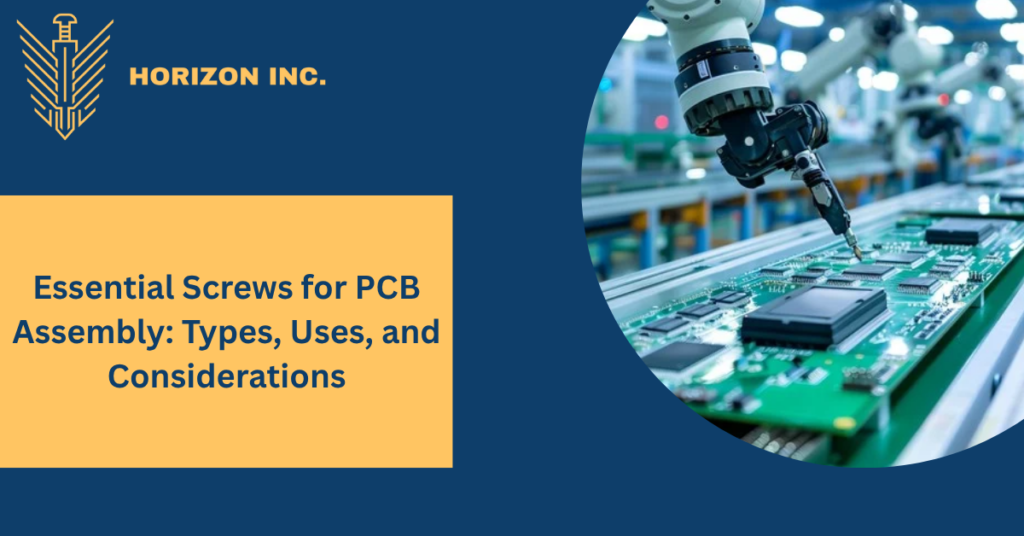In the intricate world of electronics, Printed Circuit Board (PCB) assembly plays a vital role in bringing devices to life. While components like ICs and resistors often get the spotlight, the humble screw remains one of the most critical – yet overlooked – elements of reliable and efficient PCB installation.
Fasteners, especially screws, ensure mechanical integrity, maintain electrical grounding, and enable easy serviceability. Choosing the right type of screw in PCB assembly isn’t just about physical fit – it’s about performance, safety, and longevity.
In this post, we explore the most commonly used screws in PCB assemblies, their specific functions, and what factors factory managers and engineers must consider.
🔩 Common Types of Screws in PCB Assembly
1. Machine Screws
- Types: Pan head, CSK (countersunk), button head, socket head cap screws
- Thread: Fully threaded, usually metric (M2 to M4)
- Material: Stainless steel or plated steel
- Application: Used with pre-threaded standoffs or tapped holes on enclosures or brackets.
- Advantage: Reliable torque application, reusable.
2. Self-Tapping Screws
- Types: Pan or truss head, with sharp threads
- Thread: Designed to cut threads into plastic or soft metal
- Material: Zinc-plated steel or stainless steel
- Application: Fasten PCBs directly to plastic housings.
- Advantage: No pre-tapping required, reduces assembly time.
3. Thread-Forming Screws for Plastic
- Popular Design: PT screws (Plastic Tapping)
- Features: Narrow tip, wide spacing threads
- Application: Secure PCBs to plastic standoffs or enclosures without causing stress cracks.
- Advantage: High pull-out strength, minimal material disruption.
4. Captive Screws
- Function: Retain the screw with the panel or enclosure, even when loosened.
- Application: PCB covers, shield plates, rack-mounted electronics.
- Advantage: Prevent screw loss in sensitive electronics; speeds up maintenance.
5. SEMS Screws
- Design: Screw pre-assembled with a washer (often captive spring or flat washer)
- Application: Grounding PCBs or fastening conductive surfaces.
- Advantage: Saves assembly time, provides built-in grounding.
6. Micro Screws
- Size: M1, M1.4, M1.6
- Application: Miniature PCBs in mobile devices, medical electronics
- Material: Stainless steel, brass
- Advantage: Ideal for precision assemblies where space is limited.
📌 Key Considerations in Screw Selection for PCB Assembly
- Material Compatibility
Ensure screw material (e.g., stainless steel) is compatible with the PCB, housing, and environment (e.g., corrosion resistance). - Thread Engagement
In plastic, use screws designed to maximize holding power without cracking the boss. - Clearance and Hole Design
Maintain proper hole sizing – too tight can cause stress, too loose reduces grip. - Electrical Considerations
Grounding paths may depend on metal screws or washers; ensure conductivity where needed. - ESD-Safe Materials
In static-sensitive environments, ensure screws and components used don’t generate static charges.
🛠️ Best Practices
- Use torque-limiting drivers to avoid overtightening.
- Opt for captive hardware in products requiring frequent service.
- Always follow IPC and OEM guidelines for fastener torque and hole specs.
Final Thoughts
Fasteners may be one of the smallest parts in a PCB assembly, but they can have a big impact. The wrong screw can strip plastic, short a circuit, or compromise structural integrity. The right screw, however, supports performance, ease of assembly, and long-term reliability.
At Horizon Inc., we offer a wide variety of precision-engineered screws suitable for the electronics and PCB industry. Reach out to us for customized fastening solutions that meet your design and production needs.

